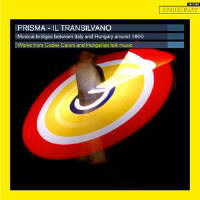Texte paru dans: / Appeared in: |
||||
|
Outil de traduction ~ (Très approximatif) |
||||
|
Reviewer: Peter
Loewen
This is a charming recording
of a little-known repertory that demonstra-tes the influence of Italians and
Italian music in 17th-Century Hungary. The name Il Transilvano is from a
treatise by Girolamo Diruta (Venice, 1593) dedicated to the Prince of
Transylvania, Sigismund Bathory. The bulk of the program, though, comes from
a 17th Century collection known as the Codex Caioni, consisting of Italian
and German music with Hungarian and Romanian folk music.
The ‘Sonata Sopra La Monica’
by Biagio Marini (1594-1663) gives Franciska Hajdu (violin) and Elisabeth
Champollion (recorder) the opportunity to show off their technical skills in
this variation of the well-known song ‘La Monica’. Works of Hungarian origin
are interlaced with Italian pieces, but they dominate in the second half.
Giovanni Picchi’s Intavolatura di Bali d’Arpicordo (Venice 1618-20) is the
source for three Hungarian Dances—’Ballo Ongaro’, ‘Paduana ditta la Ongara’,
and ‘Gagliarda Ditta la Ongara’. They consist of simple melodies of
Hunga-rian origin arranged by the Prisma nsemble over simple harmonic
foundation. The two vocal works are a revelation. For ‘Angoli Borbala’, sung
by Hajdu, the ensemble created a rustic ambience with bird songs in the
background. The song was collected by Zoltan Kodaly. This a beautiful,
though desperately sad, song about a young pregnant girl who suffers and
dies through her mother’s maltreatment. The 7/8 meter gives the music an
exotic character. The song begins in a slow, meditative tempo and then takes
on a fast tempo. Here, with recorder divisions and drone-like playing in the
violin, the song conveys a whirling, hypnotic effect. | ||||
|
||||
|
|
|
|||
|
Cliquez l'un ou l'autre
bouton pour découvrir bien d'autres critiques de CD |
||||




